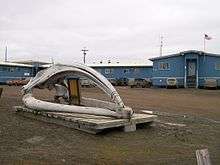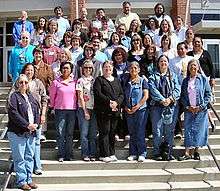Tribal colleges and universities

Tribal colleges and universities are a category of higher education, minority-serving institutions in the United States. The educational institutions are distinguished by being controlled and operated by American Indian tribes; they have become part of American Indians' institution-building in order to pass on their own cultures. The first was founded by the Navajo Nation in 1968 in Arizona, and several others were established in the 1970s. As of 1994, they have been authorized by Congress as land-grant colleges.
History
Tribal colleges are located on or near Indian reservations and provide access to post-secondary education, accredited degrees, and vocational training for both Indian and non-Indian students. Navajo Community College, now called Diné College, the first tribal college, was founded on the reservation in Tsaile, Arizona, in 1968 and accredited in 1979. Tensions immediately arose between two philosophies: one that the tribal colleges should have the same criteria, curriculum and procedures for educational quality as mainstream colleges, the other that the faculty and curriculum should be closely adapted to the particular historical culture of the tribe. There was a great deal of turnover, exacerbated by very tight budgets.[1] Several other tribal colleges were established in the 1970s and enrollment has steadily increased.[2]
Indian culture and tradition have become a part of the curricula since the 1970s, when many of the colleges were established. These institutions are generally located on reservations and face problems similar to those of other rural educational institutions: recruitment and retention of students and faculty, and curriculum issues.[3] Lack of funding, along with the minimal resources of some tribes, have been obstacles for some tribes.[4] For some Native American nations, revenues from casino gambling have aided in their building educational institutions.
In general, enrollment has increased significantly, particularly in areas where reservations have significant populations. In 1982, the total enrollment at tribal colleges in the United States was approximately 2,100. By 2003, it had increased to 30,000.[4] This also reflects a return to reservations by numerous American Indians, for instance, on the Great Plains.
By contrast, California's only tribal college, D-Q University located west of Davis, California, closed in 2005. It re-opened briefly with six students in 2006. Unlike most of the institutions, it is not affiliated with a single tribe or reservation. [5]
In 1994 under the Elementary and Secondary Education Reauthorization Act, the tribal colleges were authorized by the US Congress as land-grant colleges. Most offer two-year degrees, although six are four-year institutions, and three have master's degree programs. Several colleges, such as the College of the Menominee Nation, have developed transfer agreements with affiliated state universities to allow students who graduate from the two-year tribal college to receive junior status at the state university system.[4] Sinte Gleska University in South Dakota has a master's program affiliated with Red Crow Community College and Canadian universities in Alberta.
As of 2013, Montana is the only state in which each Indian reservation has established a fully accredited tribal college. The University of Montana "was the first to establish dual admission agreements with all of the tribal colleges and as such it was the first institution in the nation to actively facilitate student transfer from the tribal colleges."[6] The Montana legislature passed the Indian Education for All Act, creating the only state mandate for public schools to "teach American Indian history, culture, and heritage to preschool through higher education students."[6]
Affiliations
The American Indian Higher Education Consortium, founded in 1972, represents 32 tribal colleges in the US and one in Canada. The organization is jointly governed by presidents from the member institutions.[7]
Special programs

Based in Huntsville, Alabama, Tribal Earth Science & Technology Education (TRESTE) is a NASA-funded team of nine tribal higher education institutions and the Universities Space Research Association's Earth System Science Program. The collaboration is designed to enhance Earth system science and geospatial education using problem-based teaching techniques in order to inspire undergraduate students for careers in Earth system science, the physical sciences, and other fields of engineering or science.[8]
Alternate tribal higher education programs are available, including the Tribal College Librarians Institute (TCLI), a week-long professional development experience for U.S. and Canadian tribal college librarians.
Publications
The award-winning Tribal College Journal of American Indian Higher Education is a culture-based publication addressing issues in American Indian and Alaska higher education with articles by journalists and scholars. It provides a forum for tribal students, staff, faculty, and college administrators to discuss their needs, successes, and missions.[9]
Scholarships
The American Indian College Fund, originally located in New York City, but now based in Denver, Colorado, provides scholarships for US tribal colleges and universities. Foundation and private-sector donations are crucial to its success. Its mission is to transform Indian higher education through funding and awareness of the community-based, accredited tribal colleges and universities, while offering student access to knowledge, skills, and cultural values in order to enhance both the communities they serve and the country as a whole.[10]
Other scholarship programs abound, including many that are unique to a specific program, geographic area or tribe. Examples are the Tribal Training Grant, Tribal Higher Education Scholarship program, and Alyeska Match Scholarship.[11] and Intertribal Higher Education Program.[12]
The Native American Journalists Association (NAJA), founded by journalist and publisher Tim Giago (Oglala Lakota), has a foundation offering scholarships and internships to American Indian students in journalism. It sponsors three seminars annually for working American Indian journalists and those in the business end.[13]
Legal codes
Specific Executive Orders govern Indian tribe higher education operations in the United States:
- E.O. 13021 Tribal Colleges and Universities
- E.O. 13096 American Indian and Alaska Native Education
Title 25 of the United States Code defines the role of Indians in the United States Code:
See also
References
- ↑ T. Gregory and Lourene Thaxton, "Robert A. Roessel Jr. and Navajo Community College: Cross-Cultural Roles of Key Individuals in Its Creation, 1951-1989," American Indian Culture & Research Journal (2007) 31#4 pp 25-50.
- ↑ Marjane Ambler, "While globalizing their movement, tribal colleges import ideas", Tribal College Journal of American Indian Higher Education, Vol. 16 No.4 , Summer 2005, accessed 7 July 2011
- ↑ Higher Education Forum (2004-07-22). "2nd Annual Washington State/Tribal Indian Education Summit". washington.edu. Retrieved 2008-10-27.
- 1 2 3 Webster, Lori (July 2003). "Tribal Colleges and Universities: Guided by Tribal Values, Advancing Academic Study". Diversity Digest. diversityweb.org. 7 (1 & 2).
- ↑ Hindery, Robin (2006-08-12). "California's only tribal college close to collapse after 35 years". Retrieved 2008-10-27.
- 1 2 "Native American Center Facts". The University of Montana. Retrieved 2013-10-27.
- ↑ "AIHEC's History and Mission". aihec.org. Retrieved 2008-10-27.
- ↑ "TRibal Earth Science & Technology Education (TRESTE) Program". nasa.gov. Retrieved 2008-10-27.
- ↑ "A History of the Tribal College Journal". tribalcollegejournal.org. Retrieved 2008-10-27.
- ↑ "About Us". collegefund.org. Retrieved 2008-10-27.
- ↑ "Tribal Higher Education Scholarships for Alaskan Natives". aaanativearts.com. Retrieved 2008-10-27.
- ↑ "Tribal Higher Education Program" (PDF). /indiancommission.state.nv.us. p. 1. Retrieved 2008-10-27.
- ↑ Tim Giago, "Freedom of the Press in Indian Country", Nieman Reports: Covering Indian Country, Fall 2005, accessed 29 June 2011
Further reading
- Black, Vicki. 'Tribal Colleges and Universities: Perceptions of Presidents and Students.' Diss. University of Georgia, 2013. online
- Khachadoorian, Angelle A. Inside the Eagle's Head: An American Indian College (2010) memoir by a former professor at Southwestern Indian Polytechnic Institute in Albuquerque New Mexico excerpt
- McKinley, Bryan et al. Postsecondary Education for American Indian and Alaska Natives: Higher Education for Nation Building and Self-Determination (2012) excerpt
- Shotton, Heather J. et al. eds. Beyond the Asterisk: Understanding Native Students in Higher Education (2013) excerpt
External links
- US Government MSI site
- Floor statement of Senator Byron L. Dorgan on tribal college provisions in the Higher Education Reauthorization and College Opportunity Act of 2008